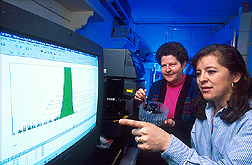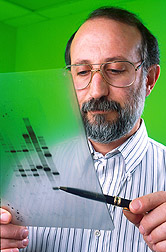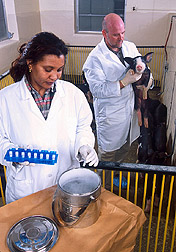Infectious Emergencies—Creating the Tools To Study Immune Response in Farm Animals |
|
|
|
A multivehicle accident just happened on U.S. Highway 100. Several witnesses grab their cell phones and dial 911. The dispatcher on the other end radios the nearest highway patrol cars and alerts fire and rescue squads to rush to the site. The first troopers on the scene assess the damage and radio back for more patrol cars and emergency personnel, while rescue workers use walkie-talkies to coordinate treatment of the injured. Good communication turns chaos into coordination. If, like Alice in Wonderland, you could shrink up and scramble down the digestive or respiratory tract of a farm animal, you could witness emergency scenes like this all along the way as viruses, bacteria, parasites—even worms—try to penetrate the lining of the animal's gut. |
|
|
But instead of using radios and walkie-talkies, cells of the immune system use proteins called cytokines to orchestrate a response. You may have heard of some of them—the interferons and interleukins, for example. Others, like chemokines, are less well-known. Over the last decade, cytokines have become a hot area of interest in the search for alternatives to antibiotics and other drug therapies for our food animals, says ARS immunologist Joan K. Lunney. She heads the Immunology and Disease Resistance Laboratory, at Beltsville, Maryland. The laboratory is at the forefront of using cytokines to answer basic questions about the immune response of pigs and cattle. In pigs, for example, Lunney wants to know at what age the immune system starts functioning and how well it functions. The trick is to find which cytokines generate a protective immune response and which either distract the immune system or cause an overresponse. |
|
|
"We know many factors affect the quality and quantity of cytokine response to an antigen or infection," says ARS microbiologist Joseph F. Urban, Jr. Some responses are appropriate and protect the animal; others are inappropriate and further stress the animal.
"It's a balancing act—the yin-yang hypothesis of regulation." Knowing which cytokines are key to maintaining this balance will enable scientists to design therapies that stimulate the desired response or suppress the undesired. Moreover, scientists will be able to select animals that have the genetic background for appropriate responses.Reagents to the Rescue To look for changes in cytokine levels, one needs reagents. So Lunney's laboratory has become a kind of reagent factory, preparing tiny molecules that can be used to measure either the cytokines or changes in their production. To measure a cytokine directly, the researchers make monoclonal antibodies—molecules that attach to specific sites on a particular cytokine. Using these monoclonals, they can measure the amounts of cytokines produced at each stage of an infection or a vaccine trial. With a sensitive fluorescence assay, they can even identify the exact cell making the cytokine. To measure cytokine production indirectly, the researchers make "DNA competitors," which enable them to detect changes in expression of the gene that codes for the cytokine. When a cytokine isn't needed, levels of the gene product—messenger RNA—are low. When the gene gets turned on, messenger RNA levels rise. Using the well-known PCR—polymerase chain reaction—the researchers make millions of DNA copies of messenger RNA for a given cytokine. Then they use PCR again to snip a chunk of bases—about 100 or so—out of the DNA copy. This yields a deleted version, called a DNA competitor. To measure gene expression for a specific cytokine, they use a known amount of its DNA competitor to serve as a kind of internal standard in the PCR assay. So far, laboratory personnel have produced DNA competitors for 11 cytokines in pigs and 16 in cattle. The researchers draw from the large database of human and mouse genes to prepare their reagents. "We have sent DNA competitors for swine and cattle to hundreds of investigators around the world," says ARS microbiologist Dante S. Zarlenga. He works with cattle and swine cytokines and developed a simple technique for making DNA competitors. His colleague, microbiologist Louis C. Gasbarre, has used the reagents to develop a framework of cattle immunity that researchers worldwide can build on. It's Beyond Complex Researchers at Lunney's laboratory are working to get the big picture of immune response in cattle and pigs. And this picture is more than complex. It will differ depending on whether the infectious agent is a virus, bacterium, protozoan parasite, or worm, whether it's a combination of these agents, what tissue is infected, and how long the infection has been around. Zarlenga is working on what he calls third-generation assays from farm animals, which will show changes in expression of many cytokines at once. He says the technology already exists to "print" thousands of minuscule dots of functional DNA on a single microscope slide. Like magnets, these dots will attract their complementary DNA—the copies researchers make from the cells they are studying. By adding fluorescent labels to the complementary DNA, researchers can estimate the degree of cytokine expression by the brightness of each dot. The technology is up and running for human and mouse DNA, says Zarlenga. He and Gasbarre are producing cytokine DNA from cattle for each of the spots on the slide. Meanwhile, Lunney collaborated with researchers at the University of Illinois-Urbana and Pharmacia Animal Health in Kalamazoo, Michigan, to produce monoclonal antibody panels for two pig cytokines. She says each antibody in a panel attaches to a different site on the cytokine, allowing accurate measurement. Trouble is, panels exist for less than one-third of the pig cytokines and are only slowly becoming available. "Most people want to measure the protein," Lunney notes, "because you can actually determine which immune cell is making it." Eventually, she hopes there will be antibody arrays for pigs and cattle like the DNA arrays Zarlenga is working on.—By Judy McBride, Agricultural Research Service Information Staff. This research is part of Animal Health, an ARS National Program (#103) described on the World Wide Web at http://www.nps.ars.usda.gov. Joan K. Lunney, Dante S. Zarlenga, Louis C. Gasbarre, and Joseph F. Urban, Jr., are with the USDA-ARS Immunology and Disease Resistance Laboratory, 10300 Baltimore Ave., Bldg. 1040, Beltsville, MD 20705-2350; phone (301) 504-8201, fax (301) 504-5306. |
|
"Infectious Emergencies" was published in the June 2001 issue of Agricultural Research magazine. |









